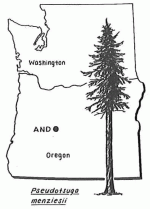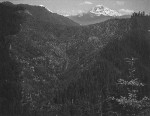Assessing how land use, natural disturbances, and climate change affect carbon dynamics, biodiversity, and hydrology
After two decades of focus on forestry research, the Andrews Forest research program shifted to an ecosystem emphasis in 1970 with inception of the Conifer Forest Biome studies within the International Biological Programme. Study of forest and stream ecosystems continued under the LTER program which Andrews Forest joined as a charter member in 1980. This year's preparation of the renewal proposal for Andrews LTER (LTER4 program, 1996-2002) triggered reassessment of long-term studies and identification of critical new projects, especially synthesis-all under reduced funding.
The central question of LTER4 is: How do land use (forestry), natural disturbances, and climate change affect three key ecosystem properties: carbon dynamics, biodiversity, and hydrology? We selected these three ecosystem properties because they are scientifically and socially important, tractable, and their responses are posited to represent different classes of ecosystem behavior at the landscape scale.
We approach this question through long- and short- term, discipline-focused component studies and through four synthesis areas. Component studies focus on:
- Aspects of spatial and temporal variability of climate
- Watershed hydrology; vegetation succession in natural and managed forests
- Biological diversity, especially among invertebrates
- Carbon and nutrient dynamics
- Forest-stream interactions through stream networks
- Landscape dynamics, including disturbance regimes
The Synthesis Areas are:
- Effects of Species on Ecosystem Function -- to assess how the abundance and distribution of species influences ecosystem functions, particularly with respect to carbon dynamics and hydrology
- Early Succession -- to understand how variation in the rate of development of conifer dominance influences ecosystem function
- Small Watersheds -- to understand the influence of post-clearcut vegetation successional patterns onstream flows from small watersheds
- Landscape Dynamics -- to examine the effects of landscape-scale vegetation patterns on carbon dynamics, elements of biodiversity, and hydrology
Small Watershed Studies
Work in the small watersheds synthesis area is developing quickly and has intersite aspects. As with other LTER sites involving Forest Service research programs [Hubbard Brook, Coweeta, Luquillo, Bonanza Creek], manipulations of paired, small (10-100 ha) watersheds have been conducted over the past 40 years to examine the effects of land use treatments. The resulting long-term records also provide opportunities to assess how varied patterns (e.g., upland vs. riparian) and rates of vegetation succession affect peak and low stream-flows.
Recent Andrews-based studies of long-term peak-flow records for small (100 ha) and large (60-600 km2) watersheds have revealed substantial increases in peak flows following clearcutting and road construction. Partial recovery appears to occur with subsequent revegetation, however, we have not yet directly linked watershed hydrology with observations of revegetation based on our numerous long-term vegetation succession plots. Evapotranspiration functions of vegetation appear to increase small peak flows during fall and spring. Removal of vegetation appears to result in increases in the larger peak flows of winter months--apparently because of greater snow accumulation and melt rates in open areas. These analyses are being extended to low flow events and geographically to two other sets of small, experimental watersheds in the Andrews Forest. Len addition, they are being applied to two sets of experimental watersheds elsewhere in western Oregon to examine hydrology- vegetation interactions over a broader range of forest types and climatic conditions.
This work is developing at the intersite level with the arrival of David Post from The Australian National University in Canberra. Dr. Post is a post-doc on NSF funding for intersite, comparative studies of streamflow in small watersheds. Peak and baseflows will be examined within and between control watersheds to reveal various influences of vegetation on evapotranspiration and snow accumulation and melt rates. The initial study sites are the Andrews, Hubbard Brook, Coweeta, Caspar Creek (CA), and Luquillo. These represent a range of snow conditions and broadleaf conifer vegetation. The number of participating sites will be expanded to other interested sites in the second year of the project.
Flood
Long-term records also provide an opportunity to interpret the effects of episodic events. A major flood February 6-8 1996 dramatically altered stream and riparian systems in the Andrews Forest triggering dozens of landslides and damaging sediment basins and gaging stations. Long-term observations of riparian vegetation channel conditions populations of species resident in aquatic and riparian habitats large woody debris in streams and landslides set the stage to evaluate geomor- phic and ecosystem responses to the flood. Our initial observations are that despite movement of so much water through the stream/riparian network disturbances in small and large streams were very patchy. This patchiness was change (e.g. landslides and moving woody debris) and site conditions tending to limit change (e.g. bedrock controls on channels) in somewhat predictable ways. Preliminary analyses ofthe response of aquatic biota reveal that salamanders survived in many sites except those most severely disturbed by landslides' trout populations were only slightly depressed where secondary channels and vegetated floodplain areas provided refuge' and sculpin populations were severely depressed apparently because of limited ability to find refuge. A variety of studies are analyzing controls on disturbance pattern and their consequences for ecosystem resistance and resilience.
The Andrews LTER continues to examine fundamental questions concerning ecosystem dynamics in a landscape subject to natural disturbance and intensive land use. While foment over conservation issues in the region has abated somewhat Andrews science and scientists are continually called upon for input to land managers and policy makers.
For more information:
- Stan Gregory 541/757-1951 sgregory@lternet
- Mark Harmon 541/750-7333 mharmon@lternet
- Fred Swanson 541/750-7355 swanson@lternet.edu

 Enlarge this image
Enlarge this image

